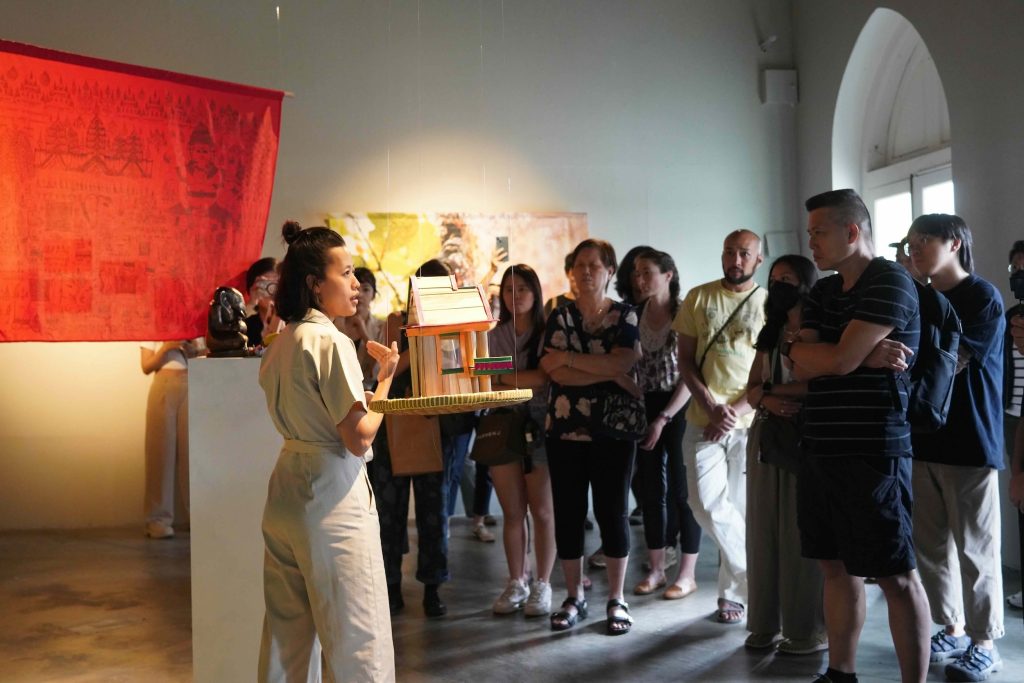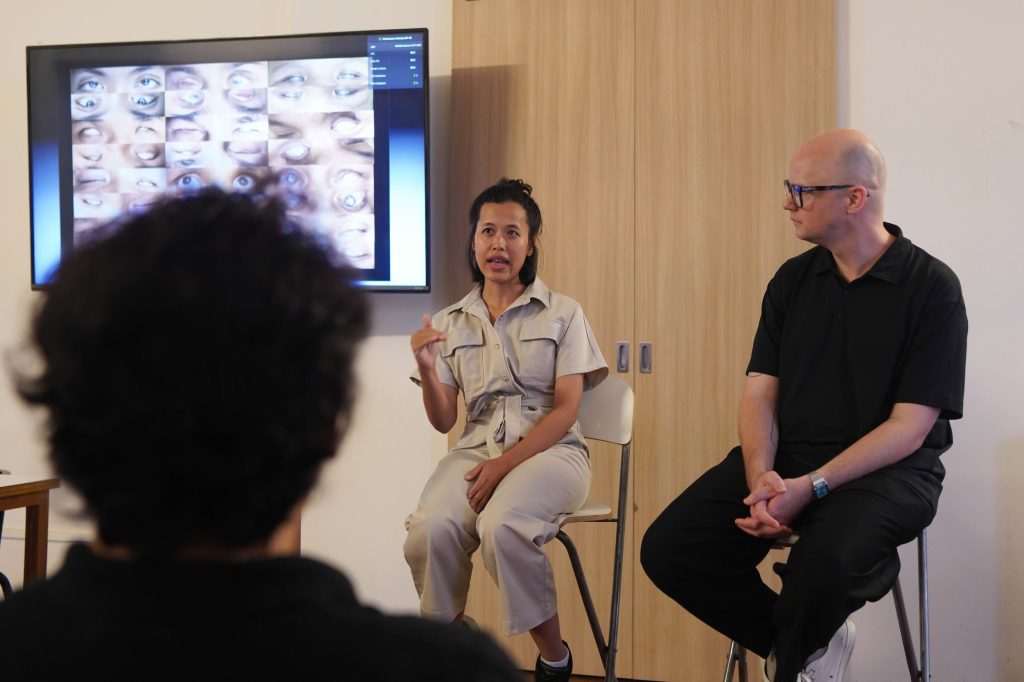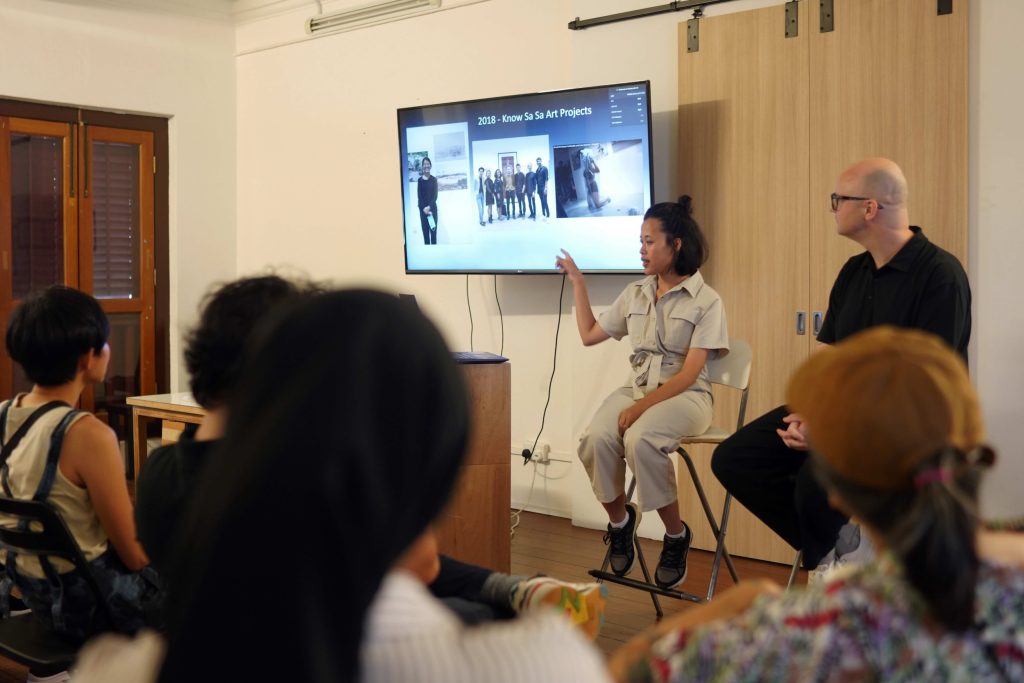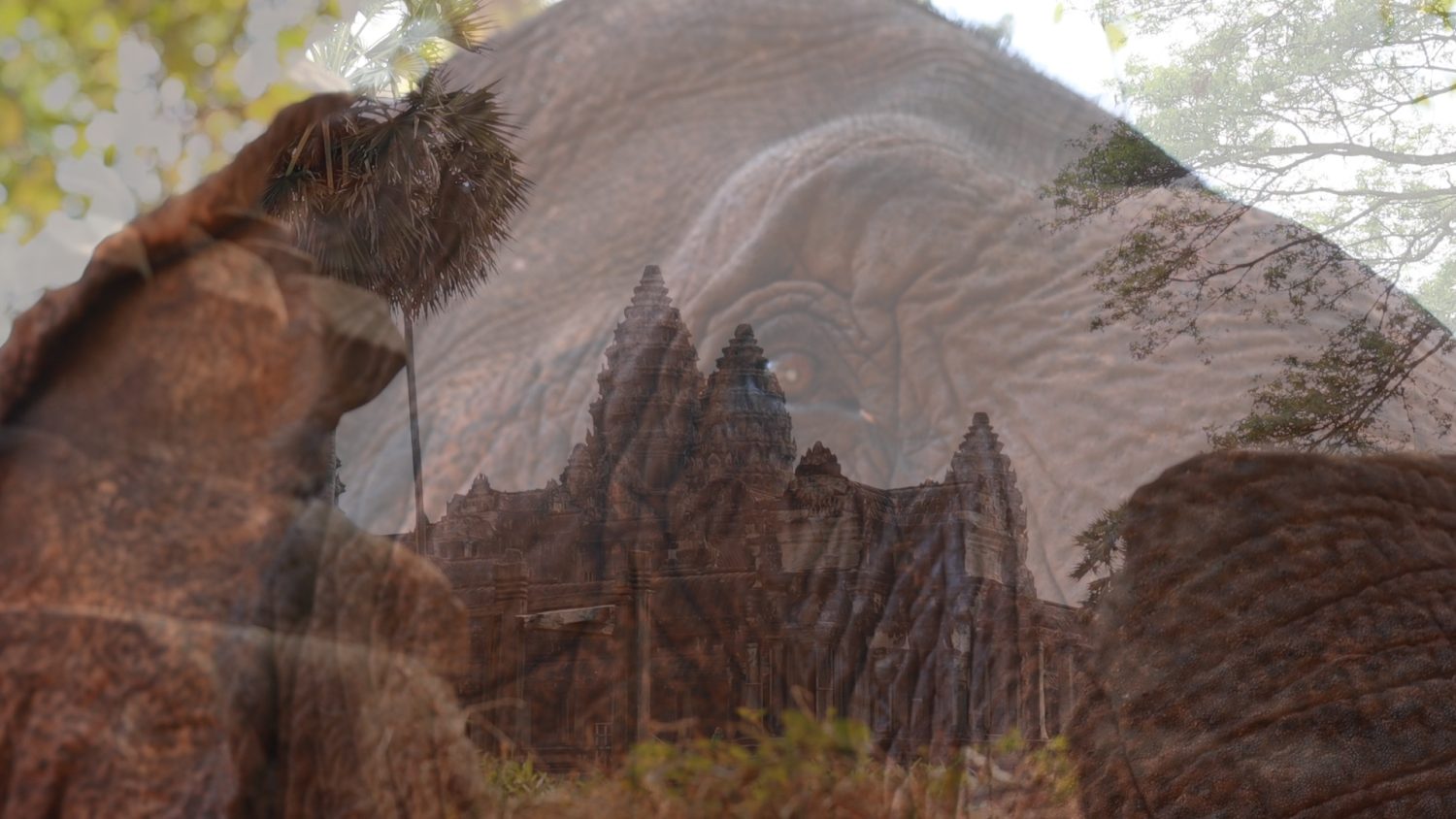On ‘An Elephant's Eye’
Cambodian photographer, Choulay Mech, recipient of the Objectifs Documentary Award 2023 (Open Category), presented her first solo exhibition, An Elephant’s Eye, at Objectifs from 18 May to 16 June 2024. Curated by her mentor, Roger Nelson, Choulay’s show explored the entangled intersections between nature and history, religion and violence, as well as humans and other animals, all done through the eyes of elephants.
The following recap presents highlights from Choulay and Roger’s conversation about the process and considerations that went into An Elephant’s Eye. This recap has been paraphrased and shortened for brevity.
On the motif of the eye and her interest in elephants
Roger: The title of the exhibition, An Elephant’s Eye, is reflected in a lot of its images, most of which are enlarged close-ups of elephants’ eyes. What drew your focus to the eye in particular, and what do you find special about an elephants’ eyes?
Choulay: My decision to focus on the eye was a result of 2 things, the first of which is personal. For those who might know, or have noticed, one of my eyes does not work as well as the other. I had a check-up done, and was told that this eye is actually restricted to a 2cm field of vision. It is also quite apparent that the colour of this eye is different, as all of you can see – it is partially pink in colour.
The second reason is because I feel we tend to associate elephants with strength [and superiority in the jungle], but few of us realise that the placement of their eyes [on the sides of their large heads] actually causes them to constantly walk into and hit the branches of trees [rather than being able to avoid them].
(With reference to her first project, which showcased a series of eyes from different individuals who also suffer from a similar condition) At that point in time, I was interested in exploring more about the issue of blindness, as well as representing those who have this disability like me. I wanted them to know that they are not alone, and neither am I. I wanted to send the message that those who are sight-impaired are just as capable of those without the disability.
Roger: So your previous work dealt more with [the topics of] disability and vision. How did you become interested in working with elephants?
Choulay: Firstly, it was truly a great opportunity for me to be able to work with elephants. In Cambodia, unless you are wealthy, the education system one goes through often leaves much to be desired. Visits to the zoo, for example, are rare, and people are not really exposed to the circumstances animals in Cambodia face.
When I got the scholarship to study at the Bophana Audiovisual Resource Centre, and could finally make my own visits to the zoo, I was surprised to find out that elephants can also suffer from similar disabilities that humans face. The elephants in Cambodia also went through the war, and have lost their friends and families, just like the humans have. The only difference – and perhaps this makes it even harder on the elephants – is that the elephants are unable to verbalise their emotions through words.
Realising all this made me want to give a voice to those who are unable to speak or express themselves, be it animals or other human beings.

On her research regarding elephants
Roger: Your research on elephants consisted of many parts. You visited the elephants and spent time with them to take their photos and video them. You also spoke to the people who care for the elephants. Then there was the reading you did online about cases of famous elephants in Cambodia. Would you like to share more about some of these cases with the audience?
Choulay: The 2 cases which stood out the most to me were Sambo’s and Chouk’s. In An Elephant’s Eye, Sambo’s story is presented through the installation of the miniature spirit house, and Chouk’s story is presented through the prosthetic leg, which used to belong to her.
Sambo’s story in particular, is very sad. After the war, she was taken back to the city, where in order to generate tourist revenue, she was made to give people rides on her back. This eventually led to her developing painful leg issues before she was returned to the forest. I was also told – and this is further explained through one of the videos playing in the exhibition – that her legs had already been scarred by cuts that the Khmer Rouge had made. It was a story that I learnt a lot from.
As for Chouk, she lost her leg when she was just a year old – can you imagine that? To have such a physical disability, be it as a human or an animal, makes life very difficult. You cannot run. I think people tend not to consider the consequences disabled animals face as frequently, but they are just like us, you know.
Roger: Who did you speak to in order to learn more about elephants?
Choulay: I spoke to individuals from NGOs, such as Nick Marx, who is a big animal lover, and not just of elephants. He was the one who donated Chouk’s prosthetic leg to me for use in the exhibition!
I also spoke to the maker of the prosthetic leg, in order to find out more about the difficulties he faced while creating it. As Chouk was the first elephant to receive this artificial limb, they had to manufacture many prototypes in order to get it right. Of course, this was an expensive process too, and raising enough funds for it was difficult.
Roger: In some of the videos playing at your exhibition, we also see other people such as monks and ordinary folk playing with elephants and making donations. Did you talk to them as well? And what do you think about the way ordinary Cambodians interact and engage with elephants?
Choulay: I have to be quite mindful about who I approach as some people are not ok with me asking them questions about their view on the elephants. I will usually hang back and observe before asking questions.
The first thing I ask myself before approaching them is why people seem so scared of elephants. Most of the younger Cambodian generation have never seen an elephant before, and when they do, they are immediately frightened. I also found out that there’s a common perception amongst most Cambodians that elephants are dangerous due to their size and strength. Because of this, they do not dare, and are also often not allowed to go up close to engage and interact with the elephants, which I disagree with.

On her ‘layering’ technique
Roger: There is the use of a ‘layering’ technique throughout your works in An Elephant’s Eye, where you layered 2 or more images together, either with photographs or videos. You considered this technique a breakthrough while you were working on this project, having experimented with many things, and you were very happy to have discovered it. Can you share more about what this technique means to you, and why you love it so much?
Choulay: I need to preface by stating that I have never believed myself to be outstanding in anything, and in addition to that, whenever I want to get something done, I want it done quickly and immediately. So, whenever Roger asked me to try something, I would be thinking to myself, “This would take so long! Especially since I am not good at drawing or say, making shadow puppets to create an interesting effect!” (she and the audience laugh)
However, when I finally explored layering photos and videos in different permutations, the feeling that the end results gave me was like no other. Documentary art is always seen as something factual and real, and therefore cannot be changed. I had to ask myself: How can we perhaps then combine all these factual issues [to give them greater depth and complexity]? This technique was so powerful for me, and I really love it so much.
Roger: I remember that you’d mentioned to me that this technique allowed you to turn your weakness into your strength.
Choulay: Yes. When I was studying at Bophana Audiovisual Resource Centre, I often received critique for my shaky-looking photos, with the main advice given to simply just keep trying to improve and take clearer photos. After a while, I felt very annoyed though, because no matter what I did, my photos didn’t get any better. This was when some others told me, why not turn your weakness into your strength?
Roger: In your use of ‘layering’, you often have very enlarged close-ups, or the image becomes very blurry – almost abstract. It becomes a bit harder to see what we are looking at. One other thing you’d mentioned to me was that you want the people who were looking at your artwork to feel more ‘free’ while viewing the images. Can you talk more about that?
Choulay: Whenever I receive the question about what I expect from my audience viewing my exhibits, I find it very difficult to answer. I do not want to place expectations on anybody. I want to give my audience freedom of interpretation as much as I want to be given the sense of freedom in making my work.
Roger: Do you therefore feel that when we look at the works using the layering technique, we are more ‘free’ in terms of how we might think or feel, as compared to the works that do not employ that technique?
Choulay: Yes, I definitely think so. It frees up perceived limitations or restrictions that a documentary show should or should not include.

On her background and how she became an artist
Roger: In a way, the exhibition reflects your background, where you have some training in photography as a contemporary art practice, and some training in filmmaking as a documentary practice. Let’s rewind a little, and hear about how you became involved with art and photography in the first place.
Choulay: Back in 2018, I had no idea what contemporary art even meant. I am thankful that I have a Cambodian friend and artist, Sao Sreymao, who helped me a lot, and is also someone whom I learnt a lot from. She took me to view art projects, and one of these was her own art performance entitled Pressure, where she placed herself into a plastic bag that made it hard for her to breathe. At that time, it all looked so crazy to me! (she and the audience laugh)
All I could think about was “Why is she doing this? What does it mean?” It was from that point onwards, as well as upon receiving the scholarship to study at Bophana Audiovisual Resource Centre, that I started to actively learn and explore more.
Art really changed my life. I was never good at academic school life, but art gave me opportunities otherwise, and another language for expression. Art allowed me to fly, to go to other countries and see and learn more.
Roger: Before you encountered photography in 2018, what were you doing?
Choulay: I studied midwifery prior to 2018, actually. I was encouraged to do so by my mother, who was also working in a hospital. Because my parents were also paying for my education, I didn’t dare to pursue things which no one else thought I would be capable of. I was pretty traumatised by my years as a midwife, because for one, my capability was constantly questioned by patients, who would comment on the issue with my eye, doubting that I could administer an injection properly. It really took away my motivation at work when I heard such comments.
The second thing was the helplessness that I felt in easing the pain felt by some women in labour who were unable to make payment for the epidural. In Cambodia, if you don’t pay first at the hospital, you can be denied an epidural. All these problems in the system frustrated and angered me.
Roger: Do you have any thoughts then, about the contemporary art system in Cambodia?
Choulay: I feel that the Cambodian government is not supportive of contemporary art. They mainly only want Cambodians to say good things about the country through any form of art that they make. We have institutions that have closed due to a lack of funding, and the government does not do anything to help. Cambodians are hungry to learn, but we don’t have access to that learning.
Roger: Speaking of that hunger, have you been surprised by the response and questions you have received here about your work?
Choulay: Yes I am! The questions I am asked also made me think harder about my own responses. For example, Chelsea (Objectifs’ Programme Director) asked me previously what my expectations of this exhibition were. Although initially I said I had no expectations, when I thought more about it, I realised I do in fact have some expectations. I want this project to change the way people think about and feel for elephants. I want its impact to reach the Cambodian government and bigger organisations, and make them want to do more for the elephants.
Recap by Geraldine Cheng, Jun 2024

